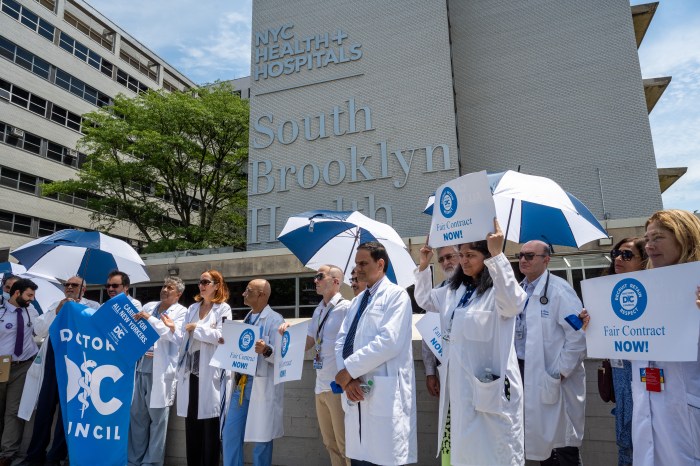As a native Brooklynite, I know firsthand the gem Downstate Hospital has been to our community. Over the years we have seen so many of our local healthcare facilities forced to operate over capacity and underfunded, but SUNY Downstate was always different, or so we thought.
The institution was state funded, politically protected, and surrounded by Black homeowners, who trusted in the quality of care for our families and our neighbors. Downstate offered ambulatory services in every field, performed innovative research, addressed health disparities and other issues, and stood as a leader in addressing the HIV epidemic in its early days. Downstate was small, but big enough to take the overflow from Kings County’s emergency room with better equipment, and more modern facilities with shorter ER wait times. It was also a major employer in both the educational and healthcare sectors, creating the perfect blueprint for success.
Then, somewhere around 2010 and 2011 all of that changed when Downstate acquired Long Island College Hospital. This acquisition further weakened Downstate’s financial stability, and threw them into closure conversations with institutions like Kingsbrook, Brookdale, Interfaith.
In 2011, while working for the NYS Senate, the then Governor had meetings with elected officials informing them he was reconvening the Berger Commission, which years prior recommended the closures of facilities like St. Mary’s Hospital. The closure of St. Mary’s devastated the community of Brownsville, putting a greater burden on the already economically forgotten communities of East Brooklyn. The reconvening of the Berger Commission meant additional closures in Brooklyn were imminent.
I was in charge of assembling a working group tasked with producing a white paper designed to offer an alternative to hospital closures recommended by the Berger Commission. We invited every health expert from every Brooklyn hospital and health-centered community-based organization, as well as advocates who understood the importance of quality local care. The working group focused on issues like payment reform, emergency room overuse and diversion, the role of community-based organizations and networks, and Brooklyn healthcare/hospital redesign. The resulting white paper was submitted to the Executive office as an alternative to the proposed Berger regulations and focused on saving Brooklyn institutions from closure.
Let me be clear: Brooklyn hospitals like Downstate, Kingsbrook (which is closing), Brookdale, and Interfaith have been critical to the borough’s healthcare infrastructure, but of late are more often than not discussed when the issue of hospital closures is raised. We have heard from local electeds, community leaders, unions, and others about the devastation this would cause for Brooklynites.
What’s at stake is a loss of jobs, the loss of healthcare services, the loss of an economic multiplier which supports small business in a Black and Caribbean community, and ultimately will lead to loss of lives. Looking back at the history of hospital closures in Brooklyn, they are located in predominantly Black communities. Every time a closure or threat of closure occurs it leaves a meteor sized crater negatively impacting those communities for decades. What is not spoken however, is once these communities recover, they no longer look the same, and are replaced with unaffordable housing, displacing much of the Black community leading to gentrification.
As healthcare continues to evolve, those who need and rely on institutions like Downstate do not have the luxury of doing the same. Healthcare in communities of color has always been based on proximity and access. People of color, elders, immigrants and the underinsured rely on community-based healthcare. Hospitals like Downstate service our aging community, which overwhelmingly does not have the luxury or means to take an Uber or a bus and train to Manhattan for basic care. Without institutions like Downstate, many more would have died during the COVID crisis because hospitals like Kings County and Brookdale were bursting at the seams.
Without Downstate, Kings County’s capacity and overflow would buckle because of the need for healthcare in the area. Let us not forget the closure of Kingsbrook Jewish. It comes to an obvious point that the lack of investment in Black communities starting with healthcare access correlates with all of the signs of social determinants of health, especially employment and housing.
Here is a novel idea to save Downstate: reduce the number of inpatient beds to a capacity that can continue to support Kings County’s overflow, maintain an emergency room, and use those beds and ER service as tools to continue teaching the next generation of doctors. Revisit the ideas of research and development and biotech, using them as revenue generating resources. Adopt two or three pillars and specialize in those areas and designate unused space to become a hub for primary care services and urgent care or a medical village.
Evolve with the changing healthcare landscape instead of destroying a community with another hospital closure. We have the power to allow our healthcare facilities to continue to serve the communities who have long relied on them for quality care.
Khari Edwards is an experienced leader in healthcare and government. Currently, he is the Head of Corporate Responsibility for Ayr Wellness, where he is responsible for providing strategic leadership and advancing Ayr’s commitment toward being a Force for Good by creating a culture of inclusion and providing avenues of opportunity in the cannabis industry.























